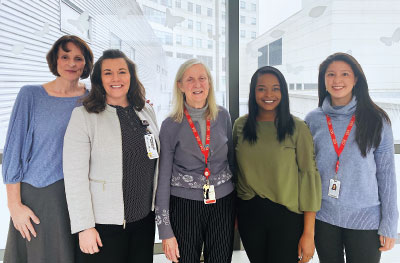Three-Day Intensive Crisis Intervention Found to Help Suicidal Youth
Abstract
Inpatient psychiatric hospitalization for suicidal youth typically lasts 7 to 10 days. A team at Nationwide Children’s Hospital in Columbus, Ohio, treats youth in crisis in less than half the time.

Last year the Centers for Disease Control and Prevention reported that the suicide rate among people aged 10 to 24 years had increased 56% between 2007 and 2017. Suicide is now the second leading cause of death among adolescents, and although inpatient psychiatric hospitalization is often recommended for young patients in crisis, many communities do not have enough hospital beds to meet the need.
Officials on the Franklin County Alcohol, Drug, and Mental Health Board in Ohio noticed these trends beginning to play out in their own community 10 years ago, when more adolescents in suicidal crisis presented at emergency departments than hospitals could handle. In response to the burgeoning crisis, the county requested proposals from local health organizations that could offer alternatives to traditional inpatient psychiatry.
Enter Nationwide Children’s Hospital (NCH) in Columbus, Ohio, where a team of mental health professionals used grant money from the county to develop and implement a three-day intensive crisis intervention composed of cognitive-behavioral, family-centered treatment. The intervention takes place at the NCH Youth Crisis Stabilization Unit (YCSU) in three phases: initial assessment, treatment planning, and engagement; individual and family cognitive-behavioral therapy and other psychiatric interventions; and safety planning and linkage to ongoing care.
“We crafted the intervention out of a compilation of what worked in outpatient settings and ways we could combine that with treatment in an intensive, short-term stay,” said Ericka Bruns, L.P.C.C.-S., director of acute services at NCH. “There was not another program like this for us to mirror, so we had to take a lot of what we knew from the outpatient standpoint as well as understand how we wanted [the intervention] to differ from traditional inpatient psychiatry.”

Multidisciplinary care is the key to success at Nationwide Children’s Hospital’s Youth Crisis Stabilization Unit. From left: Sandy McBee-Strayer, Ph.D., Ericka Bruns, L.P.C.C.-S., Mary Ann Murphy, M.D., Ph.D., Chanta Garcia, L.I.S.W.-S., and Joyce Chen, M.D.
Since then, a program that started with only two beds has grown to 12 beds and will expand to 16 beds this summer. The team sees about 1,000 adolescents each year.
Assessment and Care Plan Development
Psychiatrists are integral to the intervention and work in tandem with crisis care professionals to determine what led to the patient’s suicidal crisis.
“An important aspect of our initial diagnostic assessment is that it allows us to conceptualize the case from a more systemic standpoint,” said Joyce Chen, M.D., a child and adolescent psychiatrist at NCH. “Apart from the crisis, we explore in depth what the core issues are that the individual is dealing with. Understanding the individual’s functioning—cognitively, socially, and emotionally—helps us to create individualized treatment goals.”
Mary Ann Murphy, M.D., Ph.D., medical director of the YCSU, added, “As psychiatrists, we have the training to determine the breadth of the pathology. We assess patients in the moment of the crisis, but we also recognize that the crisis occurs in the context of the historical events—Mom’s alcoholism, Dad’s affair, what’s going on at school.”
Once patients are admitted, they see a child psychiatrist every day for assessment.
“We talk with the families and the kids and guide the therapists according to the level of pathology involved,” Murphy explained. She added that cooperation and consensus are vital to the intervention’s success. “The team, including psychiatrists, master’s-level clinicians, and [staff who work in] therapeutic recreation, meets on a daily basis in rounds and works collaboratively throughout the day on provision of care for each patient.”
Treatment
Parents and caregivers are able to stay overnight with the patients, and the team works with both patients and families. Patients participate in two or three individual sessions and one or two family sessions every day, with each session lasting 30 to 90 minutes. Individual sessions focus on psychoeducation, self-monitoring, cognitive restructuring, and mindfulness. Family sessions focus on communication skills, problem-solving skills, and emotional regulation.
“A big part of our job is to teach patients and their families new coping strategies,” said Bruns. She noted that most people have “autopilot” coping strategies—ways of managing their emotions that happen automatically. “But when we get to a crisis, we don’t always have that readiness. The goal of the intervention is to expand those autopilot coping skills” so patients and their families are better prepared for any further crises.
Because the intervention is only for a few days, the team emphasizes clear communication between patients and their families from the start.
“Sometimes we have to have conversations that they are not having at home [so we can determine] factors contributing to the crisis,” said Chanta Garcia, L.I.S.W.-S., a behavioral health crisis therapist at NCH, noting that parents are often shocked by what they hear.
“I think the parents and patients appreciate the intensity of the therapy,” said Chen. “We often hear that the issues addressed at the YCSU have not yet been discussed in other settings.”
Discharge and Aftercare
Patients are discharged only after all involved agree that treatment goals have been met and the patient is safe to go home. The team then provides families with written safety plans that emphasize close supervision and monitoring, ways of making the home safer, and resources to use in the event patients threaten to harm themselves or those around them.
“[The intervention] is not only to teach kids how to cope, but to enable caregivers to encourage their children to use those skills at home. The reality is they will deal with stress again,” said Garcia.
With an eye toward minimizing wait times, the team links the families to care in the community such as outpatient visits or referrals for family or trauma therapy. The team will also share information as appropriate with other health and mental health professionals who will be working with the patients and families.
Outcomes
So far, outcomes from the intervention have been positive. A pilot study of 50 adolescents who received the intervention found that the youth reported significantly lower suicidal ideation at 30 days and at three months than they did when admitted for stabilization. Parents and adult caregivers reported significantly higher levels of functioning for the adolescents at 30 days and three months as well. The findings were reported in the July 1, 2019, Child and Adolescent Mental Health.
The results are promising, said lead author Sandra McBee-Strayer, Ph.D., a research scientist in the Center for Suicide Prevention and Research at Nationwide Children’s Abigail Wexner Research Institute.
“Components integrated within the intervention [include] many of the evidence-based treatments currently in the literature,” McBee-Strayer said. “I think we add to the existing knowledge base by showing that a short-term crisis intervention model with these components is feasible and acceptable as an alternative to longer inpatient care.”
One challenge is that settings where parents and caregivers can stay with patients overnight are relatively rare, said Maria A. Oquendo, M.D., Ph.D., past APA president and the Ruth Meltzer Professor of Psychiatry and chair of the Department of Psychiatry at the University of Pennsylvania Perelman School of Medicine, who was not involved in the research.
“It would be wonderful if such facilities were more broadly available since the availability of psychiatric beds for children and adolescents is woeful,” Oquendo said. “We need to advocate for more investment in inpatient facilities for children and adolescents so that kids who need these interventions as well as longer inpatient stays can be appropriately treated.” ■



